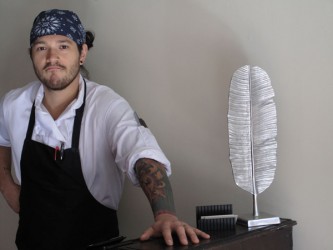Article Origin
Volume
Issue
Year
Erin Joseph Bear Robe has raised the bar on time-honoured First Nations cooking in his recently opened restaurant Keriwa Café located at 1690 Queen Street West in Toronto. And it has been a straight path of hard work from his Siksika reserve to becoming a high-end chef.
It was a part-time job in the River Café, an upscale Calgary restaurant, during his time at university that he discovered cooking as a future career. So it was back to school, this time at the Institute of Technology, where he enrolled in the school’s culinary program.
“This course included labs and practical experience in a restaurant,” Bear Robe explained. “You can push school so far, but I think on-the-job training is most important.”
At the River Café he discovered, and learned to respect, fine, regional cuisine using local in-season and organic products grown or produced without chemicals or additives.
As a graduate chef and Red Seal approved, which allows provincially-trained workers to move from one province to another, he applied to apprentice at Chef Michael Stadtlander’s world famous small country eatery near Singhampton in rural Ontario.
Ranked as one of the top 10 restaurants in the world, Stadtlander is a wizard in combing an area for farm fresh, local and foraged products. To be one of his apprentices is a life changing event.
Bear Robe then brought his newly-honed skills to Splendido Restaurant, where he met his management team. They came with him when he decided to take on Toronto with his own restaurant, specializing in farm fresh products with a First Nation twist.
But first the former tired small store in an up-market area on Queen Street West needed what amounted to as more than a face lift.
“My wife, Marta, a graphic designer, planned the ‘look’ and we did most of the finishing ourselves, but didn’t tackle the mechanical and electrical. We left that to the experts. Fires and floods from faulty workmanship were not on our agenda.”
Keriwa, meaning eagle feather, is their finished product. The restaurant’s décor is of today; sleek and friendly with touches of First Nations culture.
Grandma Maggie Bear’s deer skin dress is encased in a shadow box frame. From Bear Robe’s father’s collection of ancestral Siksika pieces, it holds pride of place on one wall.
A large birchbark mural, and an equally large collage of three dimensional wooden moulds complements another wall. A narrow strip from a traditional Pendleton blanket weaves through a leather banquette. A post-modern steel eagle feather, designed by Marta, rests on the intake desk. A much larger steel feather is repeated as a ceiling motif.
“First Nation heritage is always with me,” Bear Robe said. He attributes this to living on the Sikisika reserve as a child.
“I walk both paths; the 21st century is in the forefront, but at the same time I respect what has gone before.”
As a reminder, a long tattoo on his left arm from the shoulder to the elbow recounts his Blackfoot heritage. From the elbow to the wrist is a Scottish tartan and crest symbols of his wife’s Scottish heritage.
How does a high end chef meld ancestral ideas within a high-end restaurant? In Keriwa his staff knows just where to find wild products that enhance their menus.
Sous chef Dennis Tay explains.
“We use as much wild food as possible. A forager brings in things like mushrooms, cattails and sea asparagus, and a company specializing in wild foods supplies products such as cedar jam, birch tree syrup and juniper berries.”
And does Bear Robe have a connection with First Nations in Toronto?
“That will come,” he says. “We are new here. I can envision helping young students as I get to know the community better.”
- 2244 views

